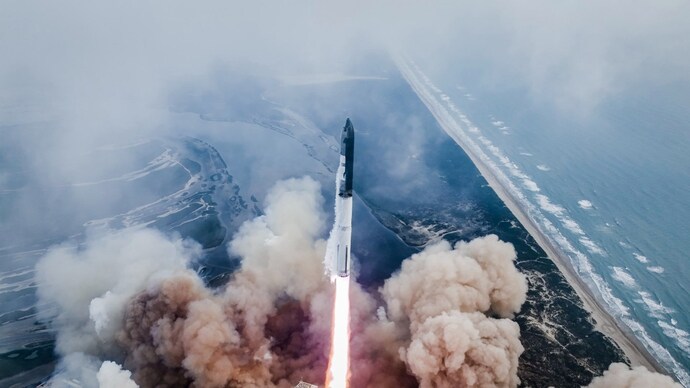Elon Musk-owned SpaceX achieved a significant milestone with the successful test flight of its Starship rocket, marking a leap towards redefining space travel.
Test Flight Details
- Successful Test Flight: Both booster and spacecraft made a gentle splashdown after an hour-long sub-orbital space flight.
- Booster Separation: Super Heavy booster detached from the spacecraft to land in the Gulf of Mexico, while the spacecraft made a controlled splashdown in the Indian Ocean.
- Spacecraft Design: Starship is a two-stage heavy lift-off vehicle designed for various missions including Earth orbit, the Moon, Mars, and beyond.
- Size and Power: Starship stands nearly 120 meters tall, making it the largest rocket ever flown. The Super Heavy booster consists of 33 Raptor engines generating 74 meganewtons of thrust.
Benefits of Starship
- Cost Reduction: Starship aims to drastically reduce the cost of space travel through payload capacity, refueling capabilities, and reusability.
- Payload Capacity: Capable of carrying up to 150 tonnes to low-Earth orbit and at least 100 tonnes to the Moon and Mars.
- Refueling Capability: The upper stage can be refueled in Earth orbit, increasing its operational efficiency.
- Rapid Reusability: Starship’s reusable design minimizes costs associated with new hardware for each launch.
Implications and Future Prospects
- Scientific Advancements: Larger payloads enable the launch of bigger space telescopes and equipment for Moon and Mars missions.
- Sample Return Missions: Starship’s return capability facilitates the retrieval of samples from the Moon and other planets for scientific research.
- NASA’s Artemis Program: Starship is central to NASA’s plans for lunar exploration under the Artemis program, with aspirations for Mars missions.
Challenges and Criticisms
- Safety and Reliability: SpaceX needs to demonstrate the safety and reliability of Starship while maintaining cost-effectiveness.
- Progress and Costs: Despite rapid development, progress has been slower than anticipated, accompanied by workplace safety concerns.
Multiple-Choice Questions (MCQs):
- How many successful attempts did SpaceX make to launch the Starship rocket?
- A) Three
- B) Four
- C) Five
- D) Six
- Answer: B) Four
- What is the purpose of the Super Heavy booster in the Starship rocket system?
- A) To carry crew and cargo to Earth orbit
- B) To make controlled splashdown in the Indian Ocean
- C) To detach from the spacecraft and land separately
- D) To refuel the upper stage in Earth orbit
- Answer: C) To detach from the spacecraft and land separately
- What distinguishes Starship from other launch systems in terms of reusability?
- A) It discards principal hardware elements after each launch.
- B) It employs disposable external fuel tanks.
- C) It allows for rapid reusability of major components.
- D) It requires months of refurbishment after each use.
- Answer: C) It allows for rapid reusability of major components
- What is one of the major criticisms mentioned in the article regarding SpaceX’s Starship development?
- A) Inadequate payload capacity
- B) Lack of refueling capability
- C) Workplace safety concerns
- D) Slow progress in development
- Answer: C) Workplace safety concerns
